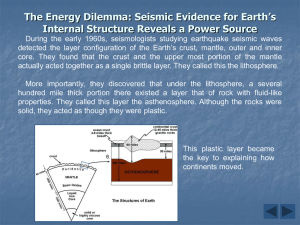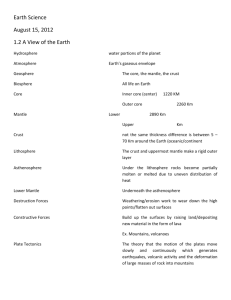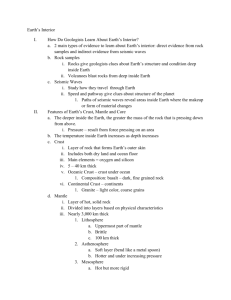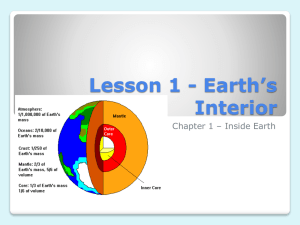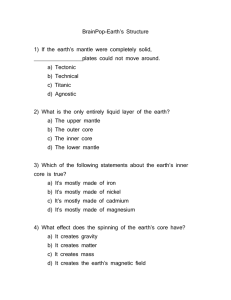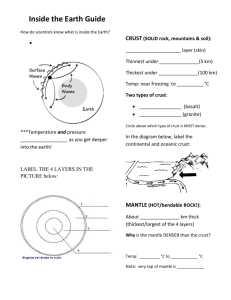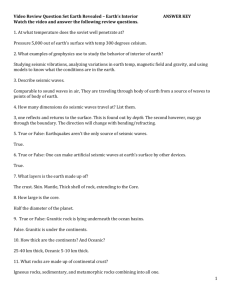GEOL-1403-McMahon
advertisement
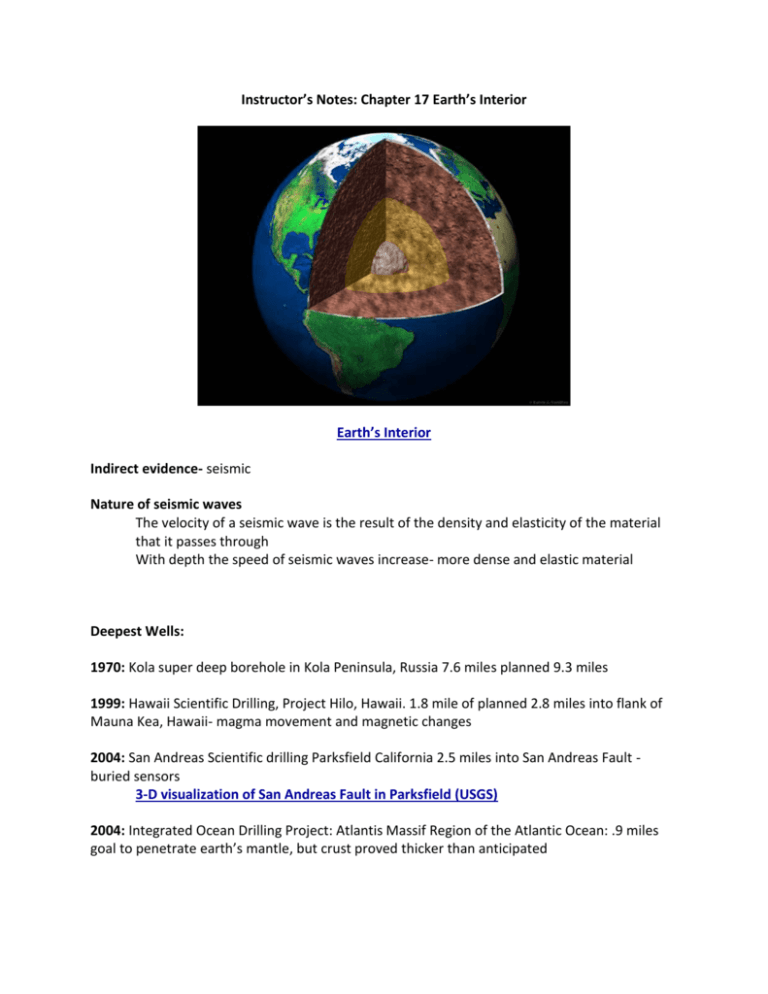
Instructor’s Notes: Chapter 17 Earth’s Interior Earth’s Interior Indirect evidence- seismic Nature of seismic waves The velocity of a seismic wave is the result of the density and elasticity of the material that it passes through With depth the speed of seismic waves increase- more dense and elastic material Deepest Wells: 1970: Kola super deep borehole in Kola Peninsula, Russia 7.6 miles planned 9.3 miles 1999: Hawaii Scientific Drilling, Project Hilo, Hawaii. 1.8 mile of planned 2.8 miles into flank of Mauna Kea, Hawaii- magma movement and magnetic changes 2004: San Andreas Scientific drilling Parksfield California 2.5 miles into San Andreas Fault buried sensors 3-D visualization of San Andreas Fault in Parksfield (USGS) 2004: Integrated Ocean Drilling Project: Atlantis Massif Region of the Atlantic Ocean: .9 miles goal to penetrate earth’s mantle, but crust proved thicker than anticipated 2006: 1.5 mile bore hole into an impact crater at the mouth of Chesapeake Bay, Cape Charles, Virginia Thickness of Earth’s Layers ( Plummer, and Carlson, 2009) Earth Crust Continental (30-50 km=18-31 miles) Oceanic (5-8 km = 4.3 miles) Lithosphere 70 km ocean to 125-250 continent Mantle Asthenosphere 200 km deep (124 miles) Mesosphere -200 km- 6000 km Core Inner (6000 km depth) Outer (2800 km-5100 km depth Seismic Waves P waves (compressional) travel through liquid S waves (shear waves) do not travel through liquid- liquid has no shear strength-it flows When seismic waves travel from one type of material to another, the waves are refracted and/or reflected Seismic Refraction Geophysics- measurement of seismic wave velocity (travel time), refraction, and reflection to interpreted the Earth’s interior Seismic Reflection The Compositional Layers of Earth: Core Mantle The boundary between crust and mantle is the MOHO (discovered by Andrija Mohorivicic) Crust Layers of Earth based on Mechanical StrengthsLayers Defined by Physical Properties (Mechanical Strength) Inner Core Outer Core Mesosphere or Lower Mantle Asthenosphere (1-5 % melting) weak zone Lithosphere 100-250 km thick (62- 155 miles) Determined by how seismic waves travel through different layers- rock composition plays a role, but is also affected by pressure, temperature, phase changes, liquid or solid state. Temperature and Pressure (Composition) Increase in pressure and temperature with depth controls the mechanical behavior of earth materials Increased temp- chemical bonds weaken lowering mechanical strength- deformation Melting- chemical bonds destroyed Pressure increases with depth making rock more dense –increasing strength- pressure raises the melting point because of confining pressure Using Travel Times to Measure the Depth of the Inner Core Earth Compositional Layers The Crust Crust varies in thickness and density, however: Oceanic crust is thinner and denser – mafic volcanic rocks (as thin as 5 km (3 miles) in some places) Continental crust is thicker and less dense - average composition of felsic igneous rocks Thickest portion of crust is found under mountain ranges (up to 70 km (45 miles) thick) Mantle Mostly indirect evidence – in the 1960’s, we did try to drill to the mantle – Project Moholenever made it- this was the precursor to deep sea drilling The Mantle is 82% of the earth’s volume The Mantle is made up of dense ultramafic rock- peridotite Evidence: inclusion in oceanic basalts Kimberlites- peridotite and diamonds partial melting of the mantle produces the mafic basalts at the mid oceanic ridges, and mantle plumes – seismic evidence stony meteorites- peridotite Experimental data Experimental Data Lawrence Livermore Labs Multi Anvil Press 250,000 X atmospheric pressure (= 700 km 435 miles) depth 2,2000C Mantle Subdivisions: Crust- Mantle boundary (Moho) is compositional change at 410 kilometers (255 miles), there is a phase change where less dense mineral due to increased pressure collapse to denser formsOlivine- spinel At 660 kilometers (410 miles) phase change where spinel- perovskite (Mg Fe) Sio3 D” layer -lower 200 km mantle – decrease in p wave velocity- partially molten- area of transfer of heat from the core to the mantle Transfer of Heat in the Earth by Mantle Convection Mantle Convection figure 19.37 The Core Larger than the Planet Mars 1/6 earth’s volume, 1/3 of the earth’s mass The Core is thought to be composed of heavy, dense mineral such as iron and nickel- which sank to the center during the early part of earth history Inner Core is Solid- Outer Core is Liquid Evidence: P wave, and S waves shadow zones P wave shadow zone - 1914 Beno Gutenberg – refraction of p waves on boundary of outer core S waves shadow zones –1936 Inge Lehmann confirmed in 1960’s underground Nuclear test in Nevada P wave velocity increases through core- solid P-wave Shadow Zone and S-wave Shadow Zone (figures 17.8 and 17.9) Evidence for Composition of the Core Density calculation of the earth indicate that the core is 11 g/cm3; 14 times denser than water (crustal rock is 2.8 X denser than water) Meteorites (metallic) high percentage of iron and nickel in solar system (crust and mantle have relatively small amount of iron)- iron and nickel have same seismic properties as the coreEarth’s Magnetic Field Evidence for solid inter and liquid outer core Core is too hot for the magnetic field to be produced by magnetic material The core must be made up of material that conducts electricity and it must be in motion Inner core is rotating 10/yr faster than earth’s surface + 1 rotation every 400yrs Axis of inter-core is offset by earth’s rotational poles by 100 Polar reversals (Other planets have magnetic fields mostly larger one where core has not cooled) Possible Origin of Earth’s Magnetic Field Geothermal Gradient Geothermal gradient - temperature increase with depth – Three processes contribute to the internal heat of earth Radioactive decay Heat released as iron solidifies in core Colliding particles during earth’s formation Heat is transferred by conduction Our plant is cooling Transfer of Heat in the Earth by Mantle Convection Seismic Tomography Numerical Modeling ( predictive or forward modeling adhering to measured data)
